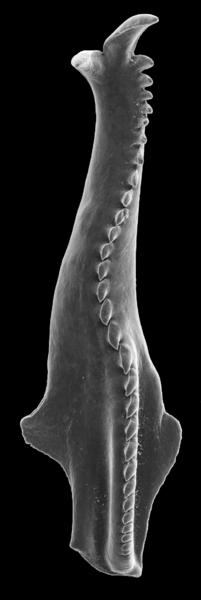
(mâchoire de vers polychaetes) appartenant ici à la famille des Ramphoprionidae.
Longueur totale = 1 millimètre.
Un scolécodonte (Scolodonta) est une pièce maxillaire de vers annélides connue sous forme de microfossiles dans le Paléozoïque.
Le géologue et paléontologue britannique George Jennings Hinde (1839-1918) fit de nombreuses études de scolécodontes à partir d'échantillons d'Angleterre, du pays de Galles, du Canada et de Suède[1],[2],[3],[4] établissant une base pour la nomenclature de ce qu'il considérait comme des éléments isolés de mâchoires d'annélides.
Notes et références
- ↑ (en) Hinde G. J., 1879. On annelid jaws from the Cambro-Silurian, Silurian and Devonian Formations in Canada and from the Lower Carboniferous in Scotland. Quarterly Journal of the Geological Society of London, 35, 370-389.
- ↑ (en) Hinde G. J., 1880. On annelid jaws from the Wenlock and Ludlow Formations of the west of England. Quarterly Journal of the Geological Society of London, 36, 368-378.
- ↑ (en) Hinde G. J., 1882. On annelid remains from the Silurian strata of the Isle of Gotland. Birand till Kungliga Svensk Vetenskapsakademiens, Hindlingas, 7, 3-28.
- ↑ (en) Hinde G. J., 1896. On the jaw-apparatus of an annelid (Eunicites reidiae sp. nov.) from the Lower Carboniferous of Halkin Mountain, Flintshire. Quarterly Journal of the Geological Society of London, 52, 438-450.
- Philippe Taugourdeau et Raymond Rauscher, 1970. Quelques Scolécodontes de la Montagne Noire. Sciences Géologiques, bulletins et mémoires, 23-2 pp. 85-93 (lien vers Persee).









